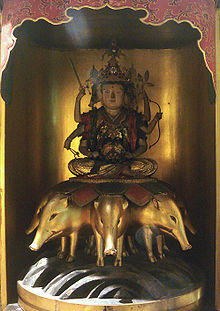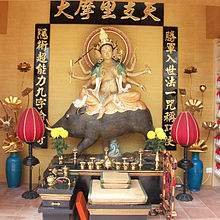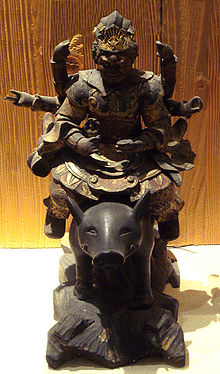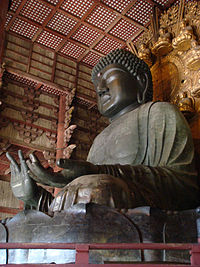- Marici (Buddhism)
-
In Mahayana and Vajrayana Buddhism, Marici is known as the goddess of the heavens, goddess of light, and a solar deity. Also known elsewhere as Marishi-ten (摩利支天), Marisha-Ten (another Japanese name)[citation needed], and Mólìzhītiān Púsà (Chinese: 摩利支天菩萨; pinyin: Mólìzhītiān Púsà). She is believed to be one of the Twenty (or Twenty Four) Heaven Celestials (二十/二十四诸天). In Taoism, Marici is known under the epithet of the Dipper Mother (traditional Chinese: 斗母元君; pinyin: Dǒumǔ Yuánjūn).
Contents
Iconic depictions
Marici has historically taken the following depictions
- As a beautiful woman sitting/standing on an open lotus, the lotus itself sometimes perched on the back of seven sows.
- As a ferocious demon perched on the back of a boar
- Riding a fiery chariot pulled by seven savage boars or sows
- As a multi-armed woman with a different weapon in each hand standing on the back of a boar.
She has been depicted with one, three, five or six faces and two, six, eight, ten or twelve arms; three eyes; in her many-faced manifestations one of her faces is that of a sow.
- Symbols
- sow
- lotus
Origins
The origins of Marici are obscure, however she appears to be an amalgamation of Hindu, Iranian, and non-Aryan[citation needed] antecedents spanning 1500 years. She is however identified as a Buddhist "goddess" of light, Marici.
In China
Marici in China is worshiped as both a Buddhist and Taoist deity where she is known as Dipper Mother (Chinese: 斗母元君; pinyin: Dǒumǔ Yuánjūn) or Maritchi Deva (Chinese: 摩利支天菩萨; pinyin: Mólìzhītiān Púsà). Most often she depicted with three eyes in each of her four faces; with four arms on each side of her body. Two of her hands are held together, and the other six hold a sun, moon, bell, golden seal, bow, and halberd. She is either standing/sitting on top of a lotus or pig, or on a Lotus on top of seven pigs. She is celebrated on the 9th day of the 9th lunar month.
In Chinese Buddhism, especially in the south where Tantric Buddhism hardly penetrated, she is often confused with Cundī. Among Chinese Buddhists she is worshiped as goddess of light and as the guardian of all nations, whom she protects from the fury of war. [1]
In Taoism she remains a popular deity and is often referred to as Queen of Heaven (Chinese: 天后; pinyin: Tiān Hòu) and is widely worshiped as the Goddess of Beidou (the Chinese equivalent of Ursa Major except that it also includes 2 "attendant" stars). She is also revered as the mother of the Nine Emperor Gods who are represented by the nine stars in the Beidou constellation.[2] Legend has it that one spring day a queen went to bath in a pond. Upon entering she suddenly felt "moved" and nine lotus buds rose from the pond. Each of these lotus buds opened to reveal a star which then became the Beidou constellation.
She is still worshiped today in Taoist temples like the White Cloud Temple and the Tou Mu Kung Temple which has both Taoist and Buddhist influences.
Bujin Marishi-ten
Marici was adopted by the Bujin or Samurai in the 8th century CE as a protector and patron.
While devotions to Marici predate Zen, they appear to be geared towards a similar meditative mode in order to enable the warrior to achieve a more heightened spiritual level. He lost interest in the issues of victory or defeat (or life and death), thus transcending to a level where he became so empowered that he was freed from his own grasp on mortality. The end result was that he became a better warrior.
The worship of Marici was to provide a way to achieve selflessness and compassion through Buddhist training by incorporating a passion for the mastery of the self.
Samurai would invoke the mantra of Marici at sunrise to achieve victory on the battlefield[citation needed], or would invoke Marici by other means to attain magical powers that would assist them in battle. Since Marici means "light" or mirage, she was regarded as the deification of mirages and was thus invisible or difficult to see and was thereby accordingly invoked to escape the notice of one's enemies.[citation needed]
Edo period
She was also later worshipped in the Edo period as a goddess of wealth and prosperity by the merchant class, alongside Daikoku-ten (大黒天) and Benzaiten (弁財天) as part of a trio of "three deities" (santen 三天).
As a Yaksha General
Marici has also sometimes included as one of the Twelve Heavenly Generals associated with Bhaiṣajyaguru, the Buddha of Medicine.
Images of her are common in India, but there are few examples in China and Japan.
See also
Chinese mythology Overview topics Major entities Creatures Bixie · Black Tortoise · Azure Dragon · White Tiger · Vermilion Bird · Qilin · Fenghuang · Huli jing · Chinese guardian lions · Píxiū · NiánPlaces Popular literary works Shan Hai Jing · Shi Yi Ji · The Peach Blossom Spring · Fengshen Bang · Legend of the White Snake · Strange Stories from a Chinese Studio · Journey to the West · In Search of the Supernatural · Zi Bu Yu · Tian Xian PeiJapanese mythology Mythic texts Kojiki | Nihon Shoki | Fudoki | Kujiki | Kogo Shūi | Hotsuma Tsutae | Nihon Ryōiki | Konjaku Monogatarishū | Shintōshū

Japanese creation myth Takamagahara mythology Izumo mythology Yamata no Orochi | Hare of Inaba | ŌkuninushiHyuga mythology Human age Emperor Jimmu | Tagishimimi | Kesshi HachidaiMythical locations Major Buddhist figures Amida Nyorai | Daruma | Five Wisdom BuddhasSeven Lucky Gods Shinto deities | Japanese deities | Sacred objects | Japanese religions Chinese Buddhist Pantheon Buddhas: Deities:
Deities:Four Heavenly Kings (Sì Tiānwáng) | Sangharama (Qíelán) | Skanda (Wéituó) | Yama (Yán Wáng) | Jìgōng |
Sudhana (Shan Cai) | Nagakanya (Long Nü) | Marici (Mólìzhītiān)Mahākāśyapa | Ānanda | Moggallāna | Bodhidharma (Dámó) | An Shigao | Xuánzàng | Fǎxiǎn | Yìjìng | Shàn Dào | Huìguǒ | Emperor Ming | Emperor Wu | Eighteen LuohansMahayana | Pure Land | Chán | Tantrism | Chinese mythology | Religion in China References
- Hall, David Avalon. Marishiten: Buddhism and the warrior Goddess, Ph.D. dissertation, Ann Arbor: University microfilms, 1990.
- Hall, David Avalon. "Martial Aspects of the Buddhist Mārīcī in Sixth Century China." Annual of The Institute for Comprehensive Studies of Buddhism—Taisho University. No. 13. (March, 1991): 182-199.
- Hall, David Avalon. "Marishiten: Buddhist Influences on Combative Behavior" in Koryu Bujutsu: Classical Warrior Traditions of Japan. Koryu Books, 1997, pp. 87-119.
External links
Categories:- Buddhism in China
- Chinese gods
- Japanese goddesses
- Buddhism in Japan
- Sky and weather goddesses
- Solar goddesses
- Lunar goddesses
Wikimedia Foundation. 2010.




